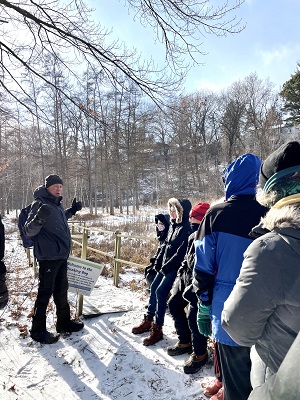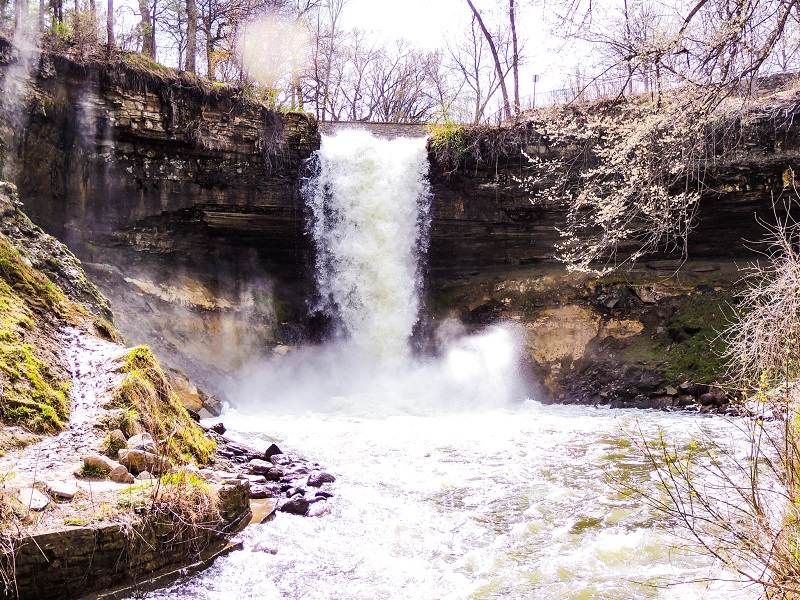
The author, Don Luce, giving a talk at the Theodore
Wirth bog on a winter outing.
Photo credit: Jean Hopfensperger
by Don Luce
When the North Star Chapter decided to restart their local outings program last November, I was eager to share some of my favorite outdoor places with other members. I wanted to lead a short hike and provide some interesting interpretation. Because most plants and animals are dormant during the winter, I decided to focus on geology. Landforms, rock layers and soil types are more visible without the vegetation leafed out.
I started with a December hike at Theodore Wirth Park. We hiked through the hilly south section of the park. I posed a basic question – why are these hills here? For a clue, we looked at the sub-soil exposed along an eroded trail. It consisted of an unsorted mixture of clay, sand, gravel and rocks: the classic composition of glacial till. Till forms as a glacier melts and drops the random assortment of materials that had been picked up in the ice. When a melting glacier edge remains in the same area for a long time, deposits of till build up to form irregular mounds, called moraines. Chunks of glacial ice are often left behind by a retreating glacier, and till builds up around them. When the ice chunks melt, they leave depressions that fill with water, forming lakes. This is how the park’s hills and lakes formed.
Another interesting feature of the park is the quaking bog, which we entered on a floating walkway. Smaller, isolated depressions filled with stagnant water create the perfect conditions for bog formation. The growth of sphagnum moss in particular aids in bog formation and the moss holds water, making the bog “quake.” Sphagnum moss releases acids into the water and blocks water flow, creating anaerobic conditions that inhibit decomposition. The build-up of partly decomposed plant remains form peat. Only a limited number of plants can tolerate the waterlogged, nutrient-poor conditions of a bog. We observed some classic bog plants – tamarack, leather leaf, Labrador tea.
I also led two hikes along the Mississippi River gorge. There we observed some of the major bedrock layers underlying the Twin Cities and much of southeastern Minnesota. Gray, blocky Platteville limestone was deposited some 450 million years ago when Minnesota was covered by a shallow, tropical sea. Many invertebrate fossils can be found in this deposit. Under the limestone is a thin layer of greenish Glenwood shale formed from deposits in mud flats near the shore. As we moved down the trail, deeper into the gorge, we came to St. Peter sandstone. White to yellow in color, this deposit is formed from beach sand washed by waves and blown by winds. It is poorly consolidated and easily eroded. The rock layers record a time when Minnesota was covered by a sea in which marine life was thriving and diversifying.

Minnehaha Falls. Photo credit: Rubin Latz
These rock layers explain one of the most significant landform features in Twin Cities: the only natural waterfall on the Mississippi River. Limestone is resistant to erosion, while the underlying sandstone is easily eroded. As water flows over the edge of the limestone, it erodes the sandstone, resulting in a sharp drop-off into a gorge. This can best be seen at Minnehaha Falls.
At the end of the last Ice Age, there was a massive waterfall near St Paul, which has been eroding upstream since. Not far upstream from the current location of St Anthony Falls, the Platteville limestone peters out. The falls are now stabilized by a concrete apron built in the 1950s. If the falls were to continue to erode upstream, they would be reduced to a series of rapids.
Don Luce recently retired from the Bell Museum of Natural History where he was curator of exhibits. He’s enjoyed getting to stay engaged in natural history education through the outings program.
Outings are proving popular with our members and volunteers; go here to join an upcoming outing.